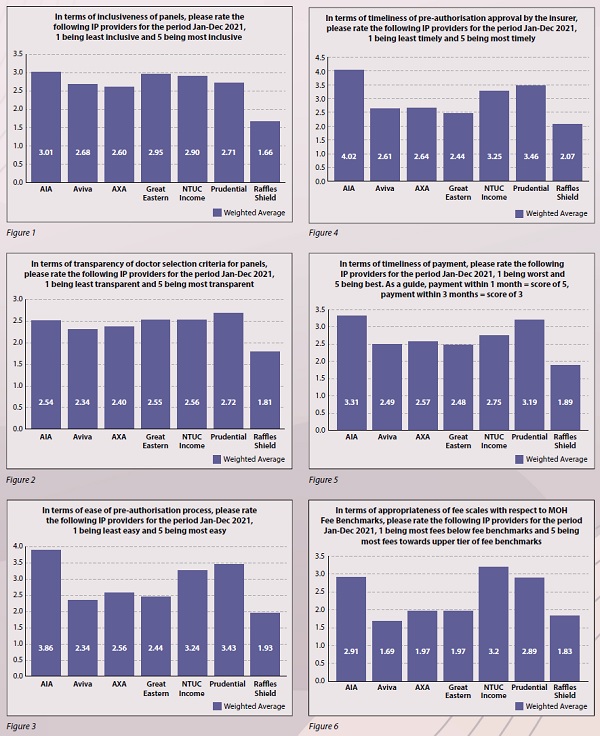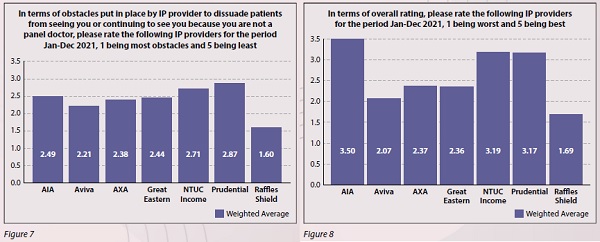In SMA's position statement on "Troubled Integrated Shield Plans (IP)" issued on 25 March 2021,1 it was stated that SMA would introduce two initiatives, one of which was the ranking of IP insurers. For a period of one month, from 5 January to 5 February 2022, SMA invited doctors to participate in a survey to rank seven providers (AIA, Aviva,a AXA, Great Eastern, NTUC Income, Prudential and Raffles Shieldb) for the period of January to December 2021. An email and two reminders were sent to SMA Members, encouraging participation and also asking Members to disseminate the survey to fellow doctors.
At the closing of the survey on 5 February, a total of 210 complete responses were received. A response is considered complete when all questions are answered, including selecting N/A (ie, Not Applicable) as a response. Respondents were required to submit their unique Medical Registration Number (MCR number) for verification purposes and to prevent a doctor from responding to the survey more than once.
The survey sought to obtain respondents' opinions on their experience with the various IP providers, in terms of inclusiveness of panels, transparency of doctor selection criteria for panels, and more (visit https://bit.ly/IPsurvey2021 for the full survey form). For most of the questions, a weighted average system was used, with the total scores divided by the number of responses. Respondents were asked to respond using a 1 to 5 scale, with 1 being the lowest, 3 being the mid-point, and 5 being the highest. A "Not Applicable" (N/A) option was also available to respondents. The answers from respondents who selected the N/A option were not factored into calculating the weighted average. An example of how the weighted average was tabulated is as follows:
53 respondents rated IP X "1" (53 x 1)
21 respondents rated IP X "2" (21 x 2)
30 respondents rated IP X "3" (30 x 3)
42 respondents rated IP X "4" (42 x 4)
43 respondents rated IP X "5" (43 x 5)
5 respondents selected N/A
Total score = 568
Total respondents (excluding those who chose N/A for the question) = 189
Weighted average = 568 / 189 = 3.005, rounded off to 3.01
Results
The survey asked respondents for their names, MCR numbers and email addresses for verification purposes. Following which, respondents were asked to indicate if they were a GP/ Family Physician/Locum, a Specialist, or Others (eg, medical administrators working in hospitals, healthcare companies, insurance companies, third-party administrators, Ministry of Health (MOH), statutory boards, medical schools), as well as whether they worked in the private or public sector.
As IP contracts are usually signed on by specialists in the private sector, we had expected the majority of respondents to be represented by them – of the 210 respondents, 87% were specialists and 98% were from the private sector.
Respondents were then surveyed on an array of questions with respect to their experience with the seven IP providers. The summary and discussion of the results are as follows:
Conclusions
Based on the responses received, more attention may be needed in the following areas:
- inclusiveness of panels,
- transparency of doctor selection criteria for panels,
- timeliness of payment,
- appropriateness of fee scales with respect to the MOH Fee Benchmarks, and
-
obstacles put in place by the IP provider to dissuade patients from seeing a non-panel doctor.
SMA looks forward to more dialogue with the IP providers, via the Multilateral Healthcare Insurance Committee (MHIC), to encourage the improvement of the healthcare ecosystem for doctors and patients. Several new measures have been initiated by the MHIC since its inception, and we hope to see further developments in the near future. If necessary and appropriate, SMA will repeat this survey on a regular basis.

